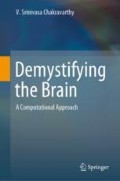Abstract
Walter Pitts and Warren McCulloch had a challenging task ahead of them. They wanted to take a first shot at developing the mathematics of the brain. When faced with the unknown, it is natural to try to express it in terms of the known. McCulloch and Pitts knew something about the mathematics of the modern computer. They worked at the time of WWII. It was also the time when the first general-purpose electronic computer, the ENIAC, was built at the University of Pennsylvania. It performed computations a thousand times faster than the electromechanical computers that existed before. Most importantly, it could be programmed. The full power of the logic of computation, the Boolean logic, was at work in ENIAC. Popular media of those days described it as a “giant brain,” referring to its monstrous size.
However opposed it may seem to the popular tendency to individualize the elements, I cannot abandon the idea of a unitary action of the nervous system.
—Camillo Golgi, 1906.
Access this chapter
Tax calculation will be finalised at checkout
Purchases are for personal use only
Notes
- 1.
1 epoch = a presentation of all patterns in the training data set.
References
Buchanan, B. G. (2005, Winter) A (Very) brief history of artificial intelligence. AI Magazine, pp. 53–60. http://www.aaai.org/AITopics/assets/PDF/AIMag26-04-016.pdf.
Cybenko, G. (1989). Approximation by superpositions of a sigmoidal function mathematics of control. Signals, and Systems, 2(4), 303–314.
Kumar, S. (2004). Neural networks: A classroom approach (736 pages). New York: Tata McGraw-Hill Education.
McCulloch, W., & Pitts, W. (1943). A logical calculus of the ideas immanent in nervous activity. Bulletin of Mathematical Biophysics, 7, 115–133.
Minsky, M. L., & Papert, S. A. (1969). Perceptrons. Cambridge, MA: MIT Press.
Rosenblatt, F. (1958). The perceptron: A probabilistic model for information storage and organization in the brain. Psychological Review, 65(6), 386–408. https://doi.org/10.1037/h0042519.
Rosenblatt, F. (1962). Principles of neurodynamics. Washington, DC: Spartan Books.
Rumelhart, D. E., & McClelland, J. L. (Eds.). (1982). Parallel distributed processing: Explorations in microcognition (Vols. 1 and II). Cambridge, MA: MIT Press.
Sejnowski, T. J., & Rosenberg, C. R. (1988). NETtalk: A parallel network that learns to read aloud. In J. A. Anderson & E. Rosenfeld (Eds.), Neurocomputing foundations of research (pp. 663–672). Cambridge, MA: The MIT Press.
Author information
Authors and Affiliations
Corresponding author
Rights and permissions
Copyright information
© 2019 Springer Nature Singapore Pte Ltd.
About this chapter
Cite this chapter
Chakravarthy, V.S. (2019). Networks that Learn. In: Demystifying the Brain. Springer, Singapore. https://doi.org/10.1007/978-981-13-3320-0_4
Download citation
DOI: https://doi.org/10.1007/978-981-13-3320-0_4
Published:
Publisher Name: Springer, Singapore
Print ISBN: 978-981-13-3319-4
Online ISBN: 978-981-13-3320-0
eBook Packages: Computer ScienceComputer Science (R0)

